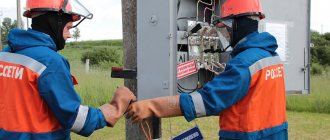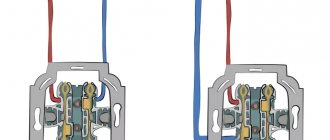Electricity and the units that operate on its basis are a great benefit for humanity, however, if handled incorrectly, it can cause great harm to both people and the environment. To prevent accidents, specialists are developing many rules, instructions, technical regulations, many points of which are literally written in human blood. In order to ensure the reliable functioning of electrical engineering and labor protection in industries where electric current is the main factor, the “Safety Rules (PTB) for the operation of electrical installations" were written and put into effect.
Compliance with safety regulations when working in electrical installations is a necessary requirement for labor protection
The current safety rules came into force in 2014 and are mandatory for all industrial consumers of electrical energy, regardless of the ownership of the enterprise.
Grounding
To protect against electric shock, grounding is used. It is organized in any room where electrical equipment is used.
A metal structure (ground electrode) is buried in the ground, to which a grounding electrode is connected. It connects the ground electrode and electrical equipment located in the room into a single circuit.
Grounding device for home
If there is no grounding in the house, then if the wire is damaged, the metal part of the equipment body will be energized and a person touching it may be shocked. If there is grounding, then in this case the current will go into the ground and will not pose a danger to humans.
Prompt service
Operational maintenance can only be performed by persons who have the appropriate knowledge and skills and who have been issued permits and permits.
Safety requirements for workers when working in electrical installations:
- Knowledge of the theoretical foundations of working with operational circuits and electrical installations.
- Manipulations are carried out only with the permission of responsible persons.
- The team must have a person with level 4 electrical safety clearance.
- You can leave the workplace only after the period specified in the work order has expired.
- It is necessary to familiarize yourself with posters and electrical safety signs at the site.
- Only people specified in the work order may have contact with the electrical installation.
Characteristics of current paths
Depending on the path of the current, the severity of the injury to the victim is determined, since the current affects all organs and tissues along the path of its movement.
The most dangerous thing is if the current passes through the heart, head or respiratory organs.
Paths of current passing through a person
The most dangerous schemes:
- hand - hand;
- two arms - two legs;
- hand leg.
Least dangerous route: leg to leg.
Also an important factor is the time of exposure to the damaging factor. The smaller it is, the less damage will be caused to the body, since even a weak current with prolonged exposure leads to severe electrical injuries.
A person can be injured without even touching exposed wires. This can happen when approaching live parts at a dangerous distance. When you are near broken power line wires lying on the ground, step voltage occurs. It is called this because it takes into account the potential difference between two points located at a distance of a human step from each other. The wider a person takes a step, the more likely a defeat is, since in this case the potential difference is higher.
When organizing electrical wiring, according to the Electrical Safety Rules, it is mandatory to provide options for automatic protection against electric shock.
These include different grounding options, the use of lower voltages, emergency shutdown systems, etc.
GENERAL OCCUPATIONAL SAFETY REQUIREMENTS
This instruction establishes the basic requirements for organizing and carrying out safe work when servicing electrical installations. 1.2. When performing work, maintenance personnel may be exposed to the following dangerous and harmful production factors: - moving machines and mechanisms, moving parts of production equipment; — increased (lowered) air temperature in the working area; — increased (lowered) temperature of the equipment surface; — increased (decreased) air humidity; — increased air mobility; - electric shock; - thermal burns; - falling from height; — increased level of static electricity; — insufficient illumination of the work area. 1.3. Persons over 18 years of age who have confirmed knowledge of electrical safety group no lower than III, have passed a medical examination and have no contraindications to performing work on electrical installations, have undergone theoretical and practical training, tested their knowledge of electrical safety and labor protection requirements, and have received permission to work independently. 1.4. Personnel servicing electrical installations are provided with workwear, safety footwear and other personal protective equipment in accordance with the Standard Standards for the free issuance of workwear, safety footwear and other personal protective equipment. 1.5. The insulating parts of tools used for servicing electrical installations that touch live parts must be made of non-conducting materials. 1.6. When performing work in explosive areas, the use of tools, clothing, and other materials that can cause sparking is not allowed. 1.7. For local lighting when working in explosive areas at night, portable battery-powered flashlights with a voltage of up to 12 V in an explosion-proof design are used. It is not allowed to turn battery-powered flashlights on or off in hazardous areas. 1.8. If a malfunction of protective equipment is detected, it is necessary to notify the immediate supervisor. The use of protective equipment that has not passed the next test is not allowed.
What important points for the safety engineer are contained in the new ones, with changes in POTEU 2020 and PTEEP
Key points important for an electrical safety engineer:
- The appointment of the person responsible for electrical equipment and his deputy is carried out on the basis of paragraphs. 1.2.3–1.2.5 PTEEP. The responsibilities of the person responsible for electrical equipment are specified in clause 1.2.6 of the PTEEP.
- An occupational safety engineer cannot be responsible for electrical facilities, since he is an inspecting person, and not electrical or electrical engineering personnel. Therefore, if there is no safety engineer on staff, his responsibilities cannot be assigned to the person who is already responsible for electrical equipment. It turns out that this person will have to check his own work, which is wrong. But responsibility for ensuring labor protection and fire safety in the department can be assigned to the person responsible for electrical equipment.
- Rules for labor protection during the operation of electrical installations are applied in all organizations that use electrical installations, electrical equipment, and power tools. Therefore, even if your organization uses only lighting fixtures, a computer and a kettle, you will still have to study in POTEU.
- Which electrical safety group which specialist needs to have is specified in Appendix 1 to the new POTEU as amended for 2020. The procedure for assigning these groups is also specified here. For example, to be assigned the 4th group, an occupational safety engineer, in addition to successfully passing exams and receiving the 3rd group, must have 3 or more years of production experience.
- Good knowledge of the requirements of POTEU and PTEEP by an OT engineer reduces the company's costs. For example, a contractor whose employees are trained in electrical safety group 2 should repair an excavator. This is an active electrical installation, so to carry out repairs, workers need to have electrical safety groups 3 and 4. However, if you make this electrical installation inoperative for the period of repair (disconnect the power cable, ground it, fill out the appropriate documentation), the 2nd electrical safety group will be enough to carry out the repair, and you will not have to spend money on additional training.
- The maximum electrical safety group that is allowed to be assigned to persons under 18 years of age is 2nd. The same group is assigned to practical students and interns. It is prohibited to include such workers in existing teams. The maximum that they can do as an exception is to act as a security post without entering a working electrical installation.
- The enterprise commission can confirm the electrical safety group and assign a new one. At the same time, she is allowed to confirm or assign a group no higher than the one that 3 members of the commission have. For example, if in the knowledge testing commission 3 people are trained in the 3rd group, they cannot assign and confirm the 4th group. Members of the commission must undergo training and knowledge testing at a specialized center or at Rostechnadzor.
- PTEEP and new POTEU as amended for 2022 allow workers who do not work with portable power tools or in electrical installations to be classified as non-electrical personnel. Such employees must be assigned group 1 annually. Instructions for the 1st group are carried out by the person responsible for electrical equipment or, on his orders, by another employee trained at least for the 3rd group from among the electrical personnel. The results of the briefing are recorded in a special journal. The safety engineer cannot conduct instructions for the 1st electrical safety group, since he is not electrical personnel.
- If the consumer’s manager has delegated the technical management of the electrical installations at his disposal to a responsible person, he himself may not be trained in electrical safety for group 2 or higher. It will be enough for him to undergo instruction for the 1st group.
- The standard timing for testing knowledge in POTEU, PTEEP for an occupational safety engineer is once every 3 years, for electrical personnel who maintain, repair, set up electrical installations, and issues orders for these works - once a year, for administrative and technical personnel who does not engage in previously specified work - once every 3 years. Moreover, before testing knowledge, the worker must undergo a medical examination and have no medical contraindications to perform the relevant work.
Electrical safety requirements when servicing the installation
The safety regulations for the operation of electrical installations spell out provisions relating to labor protection during operational switching, repair and installation operations and production work on switched-on units, both on work orders and on the instructions of foremen.
Fire safety requirements for electrical installations
So, according to the requirements, all switches in online mode are performed by employees who are part of the operational staff or specially trained for this kind of manipulation (repairmen). At the same time, at electrical units with a power of more than 1 thousand volts, employees who work independently or are shift supervisors are required to have a certificate with an access group of at least 4, and their subordinates - 3. Where the voltage is less than this mark, the tolerance group may be 3.
The rules regulate the minimum distance to which electrical installations operating without fencing can be approached by:
- non-service workers;
- hydraulic lifts;
- telescopic towers;
- excavators and tractors;
- drilling machines;
- retractable ladders or cranes;
- forklifts.
Only members of the operational corps with the 3rd group of electrical clearance or members of the administrative and technical corps with the 5th clearance group (for installations with voltages from 1 thousand volts) or the 4th group can inspect electrical units and electrical equipment of technological devices. (for electrical installations with voltage up to 1 thousand volts). Separately, the rules stipulate the conditions for inspecting overhead power transmission lines.
Those employees who are not involved in servicing electrical installations can only be admitted to them together with the personnel who are engaged in it, and it is necessary to have the 4th group of access for high-voltage electrical installations and the 3rd for low-voltage ones.
Additional Information. Admission is possible accompanied by an employee authorized to independently inspect electrical installations. Accompanying personnel are required to monitor the safety of admitted employees and prohibit approaching energized areas.
Admission of non-electrical personnel to electrical installations is permitted only when accompanied by responsible employees
If required, during the inspection it is allowed to open panels, assemblies and remote controls on electrical installations. At the same time, with units with a power of over 1 thousand volts, you cannot enter premises where there are no barriers in front of live elements. If there are such barriers on electrical installations, it is prohibited to penetrate them. When conducting inspections of electrical units, work operations and manipulations must not be performed on them.
If a ground fault occurs in electrical installations with a voltage of 3 to 35 kilovolts, you cannot approach them closer than 4-8 meters, with the exception of prompt shutdown (this is done without additional permission from the operational staff) to stop the short circuit and rescue workers, exposed to electric current as a result of an accident.
Important! It is necessary to use individual elements of protection against electrical injury. For example, turning on/off electrical devices from the network necessary for switching within it and reducing the voltage from some elements of electrical installations, as well as grounding devices (disconnectors, grounding switches) in the presence of a voltage of more than 1 thousand volts should be done strictly with dielectric gloves.
Fuses are removed and installed only when there is no voltage in the electrical installation. However, there are exceptions that allow this to be done under electrical voltage and load:
- in control, electroautomatic, measuring and control and signaling circuits;
- on transformers;
- fuses-plugs.
When manipulating fuses that are energized in the circuit, care should be taken to use an insulating rod, dielectric gloves and protective face masks to prevent thermal burns from the electric arc.
All rooms with electrical units, panels, etc. must be locked, while the keys are numbered and stored in a locked safe, their records are kept by a special employee from the operational building, and they are issued strictly upon signature. The following categories of personnel can receive a key to an electrical installation:
- employees authorized to independently inspect electrical units;
- workers providing access to work, managers and producers of work operations, observers;
- employees of operational or maintenance personnel when they carry out routine work.
Keys to electrical installations are stored in a locked safe
All keys must be returned to their storage location immediately after use. The head of the organization is responsible for accounting and issuing/returning keys to electrical installations.
Where do safety regulations apply?
The provisions of the labor protection rules concern, first of all, electrical, electrical and technological workers and some non-electrical workers who come into contact with different parts of electrical equipment during its maintenance, switching, installation and commissioning and other (including construction) types of work. Also subject to the rules are their employers: legal entities and individuals; they are obliged to guarantee safe work at their enterprises.
Note! In order to increase production reliability, employers can establish even more stringent requirements for electrical safety (of course, not in opposition to the official Rules). Workers must be familiar with the instructions on their labor protection and properly instructed
Electrical installations and lines involved in production, transmission and distribution processes must be in good working order and equipped with various protective devices and first aid.
Means of protection against electric shock
All members of the production process involving electrical energy must periodically undergo training and confirm their ability to work electrically safely (access groups I to V are assigned and standard certificates are issued), and some categories of persons must also undergo medical examinations (if workers are under 21 years old, annual) . If these rules are violated, the perpetrators bear various types of liability.
Safety precautions in military installations
Particular attention is paid to safety precautions during the operation of military stationary and mobile electrical installations.
Thus, it is strictly forbidden to remove fences from rotating elements of installations, terminals of generators, electric motors and electric converters. Personnel involved in the operational maintenance of military electrical units must wear helmets or headgear, as well as special clothing, parts of which cannot be pulled into the rotating parts of the machines.
Operating personnel of military electrical units must work in normal lighting; electrical safety is ensured by the use of dielectric matting, as well as a number of other protective measures:
- have an electrical approval group of at least 3;
- make sure that the edges of work clothes and cleaning rags are not pulled into the units;
- do not touch conductive parts of different charges, phases or grounding at the same time;
- if it is necessary to grind contact ring collectors and other rotating parts of electrical units, it is necessary to reduce the engine speed as much as possible, such work is carried out strictly in glasses that protect the eyes; it is prohibited to perform such manipulations alone;
- if an accident occurs, smoke or fire appears, electrical machines or communication equipment must be immediately de-energized;
- in the event of a malfunction of the drive device, motor or excessive vibration, which may compromise the integrity of the electrical installation, or overheating of bearings, military electrical units must also be immediately stopped and inspected;
- It is not allowed to cover operating units with tarpaulins or other sheets, but frame structures, as well as shields and casings, can be used, provided that this does not interfere with the natural cooling of the electrical installation;
- during repair maintenance of generators, electric motors and energy converters, signs “do not turn on - people are working” are placed on keys and switches;
It is necessary to post a sign about the work being carried out
- The supply cable must be de-energized by disconnecting it from the distribution panel or removing the fuses.
Cable networks for military electrical installations (in a mobile version) are made only from service wires; the presence of mechanical damage to the insulating layer is not allowed; if they are detected, the commanders of the units to which the electrical units are assigned must prevent them from being put into operation and repair the damage.
Safety regulations for the operation of consumer electrical installations comply with the basic requirements of current laws, state standards and industry norms; they also take into account the experience of operating electrical units with voltages up to 1 thousand volts and more than 1 thousand in various conditions and the suggestions of repair and adjustment specialists. This is the main official document aimed at protecting workers and protecting the industrial environment.
IV. First aid methods
4.1.1. Lay the victim on his back on a hard surface;
4.1.2. Check if the victim is breathing (by raising the chest or in another way);
4.1.3. Check the victim for the presence of a pulse in the radial artery at the wrist or in the carotid artery on the anterior - lateral surface of the neck;
4.1.4. Find out the condition of the pupil (narrow or wide); a wide pupil indicates a sharp deterioration in blood supply to the brain.
4.2. In all cases of electric shock, calling a doctor is mandatory, regardless of the condition of the victim.
If the victim is unable to breathe, artificial respiration should be started immediately. The most effective method of artificial respiration is “mouth to mouth”.
With this method, the person providing assistance places the victim in such a way that his head is thrown back as far as possible, while the tongue should not block the passage of air through the larynx. Then the person providing assistance takes several strong breaths and blows air through the mouth into the victim’s lungs at a rate of 10-12 exhalations per minute (every 5-6 seconds) until the victim’s breathing is completely restored or a doctor arrives.
4.3. If the victim has no breathing or pulse, it is necessary to carry out external (indirect) cardiac massage simultaneously with artificial respiration (air injection). To do this, determine the location of the lower third of the sternum, then place the base of the palm of an open hand on it, place the palm of the other hand on top of the first and begin rhythmic pressure on the victim’s chest. In this case, these operations should be alternated in the following order: after two blows into the victim’s mouth or nose, the person providing assistance applies 15 pressures on the chest (each pressure for 0.5 seconds), after which artificial respiration and chest compressions are repeated in the specified sequence. Artificial respiration should be performed until the victim shows signs of spontaneous breathing or until a doctor arrives.
4.4. If the victim's clothing catches fire, you need to quickly throw some thick fabric over him or knock out the flames with water.
In case of burns, you should not touch the burned area of skin with your hands or lubricate it with any ointments, oils, petroleum jelly or solutions. Do not open blisters or remove burnt pieces of clothing that have stuck to the wound. The burned surface should be covered, like any wound, with sterile material from an individual bag.
4.5
For minor bruises, a cold compress should be applied to the bruised area; for severe bruises, the victim should be carefully placed on a stretcher, clothes should be unbuttoned and cold compresses should be applied to the bruised area.
4.6. Any wound can become contaminated by microbes found on the wounded object, on the skin of the victim, as well as in dust, soil on the hands of the person providing assistance, and on dirty dressings. Even a very small wound should be protected from contamination; for a small wound, you need to take a bandage from the first aid kit and apply a bandage to the wound (you cannot wash the wound with water); In case of major bleeding, a tourniquet should be applied above the wound.
OCCUPATIONAL SAFETY REQUIREMENTS IN EMERGENCIES
4.1. If an emergency occurs (increased gas pollution, fire, smoke, unusual equipment noise, etc.), it is necessary to stop work, cut off the power supply, leave the danger zone, inform the work manager, and begin to eliminate the emergency in accordance with the emergency response plan. 4.2. If a fire occurs in electrical installations, you should use carbon dioxide and powder fire extinguishers, and if necessary, call the fire brigade by calling 101. 4.3. When extinguishing a fire, it is necessary to remember that: - sand is used when extinguishing small fires of solid and liquid substances; - asbestos cloth, tarpaulin, felt are used to extinguish small burning surfaces and clothing on people. 4.4. In case of electric shock, the victim should be freed from the action of electric current using means and materials with dielectric properties, the victim’s condition should be assessed, the necessary first aid should be provided and an ambulance should be called by calling 103 (or the victim should be transported to a medical facility).
Electric Shock Hazard
The danger of electric shock occurs not only when working with electricity, but also in everyday life. Employees whose occupation is directly related to electric current are more at risk. Fatalities from electrical injuries, according to statistics, depending on the type of industry, are about 15-30% annually. This mainly happens in case of inattention and accidental contact with live wires.
That is why compliance with safety precautions is very important when working with electric current.
Voltage over 35-40 Volts poses a danger to humans; it can lead to death without timely medical assistance. The degree of damage directly depends on the strength of the current, the design of the electrical network, the power source, contact with a damp environment and a number of other factors. Both direct and alternating current pose a threat.
Electric shock to all systems of the body is life-threatening, which leads to instant cardiac arrest. At the same time, the muscles contract, and the victim cannot independently release the live wire. Therefore, when working, electricians touch the wires with the outer part of their palm, so that in the event of an electric shock they do not grab the live cable, squeezing it even more tightly.
The main causes of electrical injuries at work can be identified:
- working with live cables without complying with safety standards;
- poor-quality grounding of electrical installations;
- lack of fencing for energized equipment;
- carrying out electrical installation work without using protective equipment;
- direct contact with wires where insulation is damaged or missing;
- faulty wiring, which can lead not only to electric shock, but also to fire;
- if “weak” connecting wires are used for high-power equipment that cannot withstand its current strength;
- increased humidity in places where welding work is performed, etc.
The main causes of electric shock to humans
Safety precautions when working on operating electrical units
Tickets with answers on electrical safety: 3rd safety group
According to the regulatory document, all production manipulations at operating electrical installations must be formalized with an official assignment on a standard form (the so-called work permit), which indicates:
- content and location of work;
- beginning and end of manipulations;
- electrical safety conditions for their implementation;
- list of employees;
- name of the person responsible for safety.
An example of a permit form for work on existing electrical installations
It is also possible to carry out such work by order of management and on the basis of a list of manipulations necessary for the current functioning of electrical installations.
It is prohibited to carry out manipulations without a signed work permit; it is also prohibited to increase the volume of work or the composition of the team without permission.
If it is necessary to carry out a major overhaul of electrical units with a voltage of more than 1 thousand volts without turning off the electricity or overhead power lines, all work must be carried out in accordance with the technological maps signed by the director of the enterprise.
The procedure for working on electrical installations with 1 thousand volts and higher voltage is as follows:
- voltage is turned off from conductive areas located near the working area (or a fence is placed) to prevent accidental contact;
- wear dielectric shoes or use an electrically insulating mat;
- an insulated tool is prepared (for example, for screwdrivers, the rod must be electrically insulated), or dielectric gloves are put on;
- if work is carried out in rooms with electrical appliances, in underground wells, various tunnels, etc., protective helmets are worn.
Additional Information. Work clothes must have long sleeves; the use of metal tools is prohibited.
In addition to the technical component, much attention in the safety rules for electrical installations is paid to the position of the worker. For example, it is prohibited to perform bended manipulations near live elements. You cannot work near them so that unfenced elements are located behind the worker’s back or on the sides, and you cannot touch insulators on conductive parts of electrical installations without using personal protective equipment.
It is not allowed to carry out manipulations without sufficient, uniform (non-glare) illumination of the working area. During operations to change wires with accompanying insulators and fittings, in order to prevent intersection with the above-laid power cables, it is necessary to tension synthetic ropes, having previously secured their ends. Raising such a rope should be done gradually and carefully.
Work on overhead lines, power lines consisting of several cables, etc., should be stopped during a forecast thunderstorm.
Employees performing work on wires are allowed to move along them, however, their cross-sectional area must be at least 2.4 square meters. cm (for cables - not less than 0.7 sq. cm), they must be in satisfactory technical condition, without damage. If the wires are split, it is necessary to use a safety belt with its slings secured to cables or to a special trolley.
When walking on split wires, use a safety belt.
When servicing ceiling lighting fixtures in industrial premises, a team of at least two employees is required: one must have at least group 3 electrical clearance, he performs work manipulations, his partner is obliged to monitor him and the electrical safety measures at the work site.
When using overhead crane trolleys, it is necessary to observe safety precautions when working at height, and the electrical voltage should be removed from the trolley cables. The crane operator receives orders about the movements of the bridge or trolley directly from the manufacturer of the work operations, while the crews are required to be in the cabin or on the deck of the walkway (if they are located in the crane trolley, the trolley cannot be moved).
II. Safety requirements before starting work
2.2. Prepare the work area for safe work:
clear aisles, driveways and cargo storage areas from foreign objects;
check the sufficiency of lighting of passages and cargo storage areas.
2.3. Check the serviceability of tools, equipment and accessories.
2.4. Prepare and arrange in order the raw materials necessary for the work.
2.5. To prepare the workplace or when working with stress relief, the following technical measures must be carried out in the specified order:
A). The necessary shutdowns have been made and measures have been taken to prevent the supply of voltage to the work site due to erroneous or spontaneous switching on of switching equipment.
b). Prohibiting posters are posted on drives and remote control keys of switching equipment.
V). The absence of voltage on live parts that must be grounded to protect people from electric shock has been verified.
G). Grounding has been carried out (grounding blades are turned on, and where they are missing, portable grounding connections are installed).
d). Warning and ordering posters are posted, workplaces and remaining live parts are fenced, if necessary.
Depending on local conditions, live parts are shielded before or after grounding.
Repair personnel begin work only after being cleared by the electrical personnel servicing this installation.
2.6. When using hand-held electric machines, portable lamps and portable power tools, before starting work you should: - determine the class of the machine or tool from the passport;
— check the completeness and reliability of fastening parts;
— make sure by external inspection that the cable (cord), its protective tube and plug are in good condition, the integrity of the insulating parts of the housing, the handle and brush holder covers, and protective covers;
— check the operation of the switch;
— perform (if necessary) testing of the residual current device (RCD);
— check the operation of the power tool or machine at idle speed;
— check for class I machines the serviceability of the grounding circuit (machine body - grounding contact of the plug).
Measures for safe work performance
POT RM 016 2001 (Labor safety rules)
Safety regulations when working on electrical installations provide for a number of organizational measures that are aimed at their strict compliance:
- work within the framework of ordinary operation of electrical units is documented in orders, orders or lists;
- preparation of the work area and access to it is issued with the appropriate permit;
- To carry out work manipulations, permission is required in accordance with the assigned electrical safety group;
- provision of insurance and control during the period of work;
- official registration of the beginning and end of a break in work, as well as their complete completion or transfer of the team to another site.
The document defines the circle of workers who are responsible for the safety of work processes at electrical installations:
- those signing permit orders, issuing orders or certifying a list of work on the current use of electrical units (the required electrical safety clearance group is 4-5) - they are required to first assess the need to perform the work and the possibility of its safe implementation; the composition of the teams, the selection of the supervisor and work contractor and preliminary briefing must meet safety requirements;
- permitting the preparation of work areas (access group - 4-5 or administrative and technical employees authorized by order of the enterprise management) - are responsible for the timely and safe disconnection of electrical equipment from the network and its grounding, coordinating working hours and the location of operational teams, accounting for teams and their members, tracking information about the timing of current manipulations and the time of supplying voltage to electrical installations;
- designated responsible work managers (access groups - 4-5, are appointed when using various mechanisms and lifts, de-energizing electrical equipment, on cable communication lines near transport highways, on newly launched overhead lines or their phase repairs, when working with induced voltage and in a number of other cases) - are required to monitor the implementation of the stages of preparation of the workplace, the sufficiency and correctness of instructions to team members, the general safety of working moments, and take additional electrical safety measures;
- those allowed to work (member of electrical technical personnel with access group 3-4) - bears responsibility for the sufficiency of safety measures, their compliance with the permit or order, the requirements of upcoming manipulations on electrical equipment, the correctness and scope of the instructions provided;
- direct performers (electrical approval group - 3-4) - are responsible for the correctly prepared work area, the presence, sufficiency and serviceability of individual and general electrical protective equipment, tools and devices, visual information in the form of safety icons or warning posters, fencing of dangerous places, for following safety rules for all team members and control over the safety of their actions during the work process;
- observers in teams (electrical admission group - 3) - monitor the compliance of the work area with safety measures; clarity and sufficiency of preliminary briefing; safety of locks on drives, fences and grounding devices; protection of workers from electrical injuries;
- All employees - members of the team carrying out routine work on electrical installations are required to comply with safety regulations, instructions and instructions regarding the safety of their labor.
The admitter may also be a member of the work team. In general, for each employee of a brigade team with the 3rd electrical safety group, you can hire one worker with the 2nd group, but in total no more than three such workers are allowed.
Line repair
The rules for repairing lines oblige the team to organize grounding within a radius of 20 meters from the work site. Any activity outside this circle is prohibited. If several teams are working on a site, then each must have its own grounding.
Workers can move directly along cables for convenience if they are at least 70 sq. mm. transverse area.
Work on damaged lines
During line repairs it is prohibited:
- Use of traverses during phased repairs.
- Climb onto power transmission poles to inspect the breakdown.
- Move under damaged supports at night.
- Move closer than 8 meters to exposed wires.
The procedure for issuing orders
Rules for labor protection during operation of thermal power plants
A work order is a document that contains information on upcoming activities. It is issued by management before preparing for the shift and setting up the workplace. There must be two certified copies in total, one remains with the boss, the other is given to the senior in the brigade.
Important! The work order indicates how many people are in the brigade. If you need to add people, then the document needs to be replaced.
Outfits can be scheduled over the phone. An authorized person is required for this. In total, in this case, 3 copies of the document are drawn up, 2 are filled out by the manager, and the third is filled out by the person responsible for issuing.





